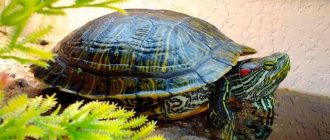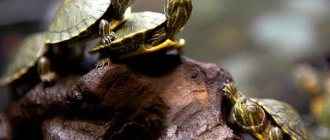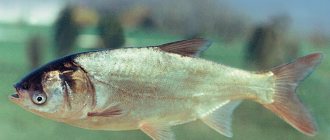When purchasing a turtle as a pet, it is reasonable to wonder what you can feed the turtles. Frivolous owners often begin to experiment with food, offering the new tenant either meat, cabbage, or milk.
However, this approach can end disastrously for the animal, which may get sick or die. Therefore, when giving a “living gift” to yourself or your children, it would be a good idea to first learn how to structure a turtle’s diet so that it will delight everyone with its presence in the house for a long time.
What do turtles like?
Most turtle species are herbivores. Therefore, about 80% of the daily diet should be all kinds of greens, and the remaining 20% should be other foods, which include vegetables, fruits, sometimes fish, vitamin and mineral supplements.
It is advisable to plan this 20% in advance a week or month in advance so that the turtle’s nutrition is balanced.
You should not overfeed the animal, but starvation will not do any good. Therefore, it is very important to know how to feed your turtle properly.
What not to feed
Aquatic turtles are omnivores. They can eat almost any food offered to them. But you shouldn't do this. They cannot digest all the food, which will disrupt the functioning of the gastrointestinal tract and lead to illness.
What not to give to turtles:
- food from the table;
- fruits and berries with seeds;
- sea fish;
- river fish of fatty varieties;
- onions, radishes, eggplants (they are spicy for animals);
- citrus peel;
- pork, lamb (too fatty, it is difficult for turtles to digest such meat);
- amber snail meat;
- elodea (contains poisonous juice).
Video on the topic. What can you feed a red-eared turtle?
Supplement to main food
You can add the following products to your turtle's daily food:
- sunflower seeds;
- Champignon;
- dry yeast;
- a piece of fresh fish.
Veterinarians recommend ready-made dry mixtures as a supplement, as well as vitamin and mineral supplements, which can be found in specialized stores. In the photo of turtle food on the Internet you can see what the finished food looks like and choose the appropriate option.
Once a week it is worth offering the turtle a boiled hard-boiled egg, and once a month - a garden snail, slug or large insect.
If the owners have acquired young animals, then the question naturally arises of how and how much to feed the small turtles. The diet of children is no different from the diet of adults.
The only point is that it is worth offering feeding to young animals not once a day, like adults, but twice.
Note!
Domestic turtles - the most popular species, cultivation features, tips for care and maintenance (115 photos + video)- Indian snakes: sacred, poisonous, most common and dangerous types of Indian snakes and their names (130 photos)
Small snakes - an overview of popular and rare species, habitats, food and names of snakes (115 photos)
Drink
These reptiles do not require daily water intake. Reptiles obtain the necessary fluid by consuming succulent food - greens, vegetables and fruits.
They have the ability to absorb the right amount of water through the pores of the skin. It will be enough to place a water tank in the terrarium 1-2 times every week for 15 minutes. The water level should not be too high, about halfway through the shell. The head is located above the surface of the water. The reptile will not suffer from thirst. The water balance in the body will be at a stable level.
Prohibited Products
Despite the reptile's apparent readiness to eat everything that is offered to it, there is a list of foods that should absolutely not be given to turtles.
These include:
- all types of buttercup, nightshade and medicinal alkaloid-containing herbs;
- citrus fruit peel;
- all types of prepared food intended for other domestic animals;
- poultry and livestock meat, even boiled;
- any home-cooked dishes, including all dairy products, bread, cereals.
Reproduction
Mating occurs in conditions of satiety, warmth and humidity all year round. It is recommended, a couple of months before the expected mating season, to place males and females in different enclosures, and preferably rooms, so that the animals do not see each other. It is recommended to place males with females.
A turtle's pregnancy can last from a week to two months. If the female is not satisfied with the conditions for laying eggs, she is restless and may refuse to eat. A few days before laying, the female will begin to look for a suitable place and dig the soil. It is recommended to organize a special box.
Eggs can be different in shape, round and oval, white and yellowish. Incubation of eggs lasts about two months. It is strongly recommended to move the eggs into a special incubator and check them daily for spoilage - rotten eggs may appear and ruin the entire clutch. The female is not interested in the clutch; further care of the babies falls on the owner.
How to determine gender
Gender is established at the stage of embryo formation in the egg. However, in most cases it is possible to accurately determine sex only after the animal reaches sexual maturity and the appearance of secondary sexual characteristics. Typically, at home, a turtle reaches maturity at the age of 2.5 to 5 years, depending on the species and conditions of detention.
There are a number of procedures that can help reveal gender earlier, such as:
- blood test for a certain number of hormones;
- radiography;
- Ultrasound;
- endoscopy.
Often such studies are uninformative and costly, and are resorted to in especially rare cases.
Let's look at how the sex of an animal is determined based on secondary sexual characteristics.
Carapace
In males: elongated, narrow, concave, quite high, noticeably smaller than in females, the posterior end has a V-shaped appearance.
In females: rounded, short, relatively flat, noticeably larger in size, the rear end is rounded.
Tail
In males: long and thin, the cloaca is located 1/3 from the edge of the shell, and looks like a longitudinal line.
In females: short and thick, the cloaca is located close to the carapace, has the appearance of an asterisk.
Limbs
In males: the claws are curved and long, quite sharp, the forelimbs are slightly longer than those of females, and well-defined femoral spurs.
In females: the limbs are shorter and more massive than in males, the claws are short and blunt.
Head
In males: the head is larger, the nose is sharper.
In females: the head is smaller than that of males, and the nose is not so pointed.
Important! Depending on the species, males and females differ in eye color.
It is also worth noting that male aquatic turtles can “show off their voice” - squeak to attract attention. They are more active than females and can show some aggression and chase other turtles even at a fairly young age.
Features of feeding turtles
Turtles are diurnal animals, so they are offered food in the first half of the day, when the animal is most active. It's best to have it at the same time.
The winter diet will definitely differ from the summer one, but don’t let this scare the owners. After all, turtles in nature change their habits with the arrival of winter, and many are not averse to hibernating.
In any case, the activity of pets in winter decreases somewhat. This also affects the reptile's appetite. She eats less, preferring dry food.
Attentive owners always notice changes in their pets’ food preferences in time and try to please them.
However, an alarming moment can be a long and causeless refusal of the animal to eat. In this case, it would not hurt to consult a specialist to prevent the death of your pet. In general, with proper nutrition, turtles grow well, move actively and delight household members with their exotic appearance.
Conditions of detention
You need to create an aquatic home for an animal based on the type of turtle, since each has its own nuances.
Keeping turtles in an aquarium comes down to meeting the general and basic requirements for aquatic turtles:
- an aquarium with a volume of at least 50 liters;
- presence of heat and light sources;
- a sufficient amount of food needed for a particular type of food.
Requirements for an aquarium
Only a horizontal terrarium is suitable for a turtle, since animals prefer to swim longer. Although the depth is of little importance for reptiles of this class, it is worth paying attention that the height of the container should be at least 30-40 centimeters. The material of the house should be durable glass or plastic, but it must be non-toxic. If a completely enclosed aquarium is intended, ventilation must be provided. Tap water is also suitable for filling, but it is better to use settled water and pour a volume that covers a little more than half the container.
Important! There is an interesting calculation of the length of its aquatic house required for an animal: the length of the aquarium should be 7-8 times the length of the shell of an adult animal.
To see the locking turtles, you need a glass house with at least 50 liters of water. It is recommended to line the bottom with bulk soil and plant several underwater plants - this way the animal will live in conditions close to natural conditions. Be sure to build a shelter at the bottom, it can be a piece of driftwood or a clay pot, or any other decorative element will do, the main thing is that it fulfills its main function - protection, and the reptile fits well in it.
Flatback turtles are a little more demanding in terms of living conditions, and they must be taken care of in a special way, otherwise the animal is unlikely to survive for long. This species cannot be kept together with other species. An aquarium with a volume of 50 liters or more is lined with small pebbles along the bottom, a layer of about 2 centimeters.
Spotted turtles need a container with a volume of 70 liters or more. Among all aquatic turtles, they are considered the most active, so it is necessary to provide sufficient space for swimming. The bottom is lined with gravel; underwater plants would be useful.
For Chinese turtles, not just an aquarium is created, but a real house with a volume of 100 liters or more. An island of land must be built on which several large stones are placed so that in the future they can be heated with a heat lamp. The bottom must be lined with soil, several underwater plants are planted, and decorative elements are installed.
Important! Amphibians, or semi-aquatic species, the Chinese and red-eared turtles, can easily leave their home over the rocks of a land island and go on a walking journey around the apartment. To prevent this from happening, it is recommended to cover the part of the aquarium with dry land with glass or a special lid.
Necessary equipment
The terrarium must be equipped with the following elements:
- Submersible heater for maintaining a constant temperature in the aquarium, on average from 20 to 25 degrees, depending on the type of animal and time of year. A device made of glass or plastic is immersed in water. A plastic device is preferable - it is stronger, has a safe suction cup, and the reptile will not get burned on it if it touches it.
- Thermometer for constant monitoring of the temperature in the terrarium.
- A water filter can be connected to an aeration device; it is necessary to purify water and enrich it with oxygen. The air tube of the aerator must be brought to the surface.
- A light lamp with a timer is necessary for the proper organization of daylight hours (from 9 to 13 hours, depending on the time of year and the type of animal).
- Land surface for semi-aquatic turtles. An island of land in an aquarium is, without a doubt, mandatory, but it is no less preferable for aquatic ones - there the animal can rest and warm up.
Temperature
For a specific subspecies, a certain temperature is set. The average is from 20 to 26 degrees.
Photo of turtles feeding
How to find out age
Unfortunately, sometimes even store salespeople are unable to accurately tell the age of a red-eared turtle, so owners have to deal with this issue on their own. The following data will help you find out the age of a reptile:
- 2 years – females 8-9 cm, males – 7-8 cm.
- 3 years – females 10-14 cm, males – 8-10 cm.
- 4 years – females 13-16 cm, males – 12-14 cm.
In addition to calculating age based on pet size, you can find out the approximate number of years in the following way:
- Shell color - in young turtles the coating is green. After 4 years of life, the shell begins to darken; in older reptiles the cover is almost black.
- Rings – rings are formed on the shell when reptiles reach one year, 2-3 rings are added every six months. After 4 years of life, the ring appears once a year. By counting the number of rings, you can roughly estimate the age of the turtle.
Food
The favorite food of ordinary musk turtles is small fish, aquatic insects, mollusks, shrimp, algae; these reptiles do not disdain a variety of carrion, for which they have earned a reputation as orderlies of reservoirs.
If a musk turtle lives in a home terrarium, then, given its taste preferences, there is a high probability of contamination of the water with food debris, so for feeding it is recommended to use tweezers or special needles adapted for threading food. Most likely, the turtle will not immediately understand the purpose of such devices, but if you wave a tasty piece of meat in front of its nose, it will get used to it quite quickly. Mobile young individuals can begin hunting for small fish kept in the same aquaterarium, for example, guppies.
Variety of choices
The usual length of small turtles is from seven to thirteen centimeters. When buying a water baby about five centimeters, you need to understand in advance that it may increase slightly in size over time. Several types of turtles are well suited for quickly adapting to home keeping.
Musk (Sternoterus)
It is a representative of the genus of mud turtles, and the smallest specimen. Its length does not exceed fourteen centimeters, and the average size of the shell is seven centimeters.
A special feature of the musk turtle's structure is its long neck. She can easily reach her hind legs with her jaw. Its carapace is smooth, but at an early age there are three clearly visible grooves on it. The turtle has a dark, uniform color, only light stripes are present on the head.
This turtle has a long neck
In its natural environment, this waterfowl lives in the south and east of the United States, and much less often in Canada. Small reptiles prefer freshwater bodies of water with muddy bottoms. They spend most of their lives in water.
Spotted (Clemmys guttata)
A fairly common species of turtle among exotic lovers. Domestic aquatic little beauties are recognizable by yellow spots located along the entire plane of the carapace - the dorsal shield of the turtle shell. Such spots are also present on the head, neck and paws.
This species can reach a length of no more than twelve centimeters. The neck of this turtle is quite short. Spotted turtles have a creamy-yellow ventral shield (plastron) with large black spots over the entire area.
In their natural environment, these creatures live almost throughout the Atlantic coast of the United States. Rarely found in Canada. In living conditions, they prefer swamps, small rivers with silted bottoms, and swampy wooded areas. They overwinter on the muddy bottom of reservoirs.
12 cm is the maximum height of this turtle
Flat (Platemys platycephala)
It is a species of the snake-necked turtle family, as well as the only representative of the species of flat turtles. The usual body length is 14-15 centimeters, rare specimens reach eighteen.
This cute version of small aquarium turtles features an orange and yellow head pattern that resembles a crown. The carapace in babies is dark brown with a yellow edging, and the plastron is yellow. This color scheme often plays a decisive role in deciding whether to keep this species at home.
The only species of the genus flat turtles, which previously also included some other species of the family.
The turtle has a long neck with small spines. The dark tail and paws contrast beautifully with the variegated color of the smooth and somewhat flattened shell. The chin is decorated with a cute mustache.
This species often lives at home due to its bright appearance and calm nature. Flat turtles can be kept several times in one aquarium. The calm environment can only be disturbed by males during the mating season.
Reeves pond turtle
This species (Chinemys reevesii) is often found in domestic pet stores. The length of the oval-shaped shell in adults does not exceed thirteen centimeters, so they can be kept in an aquarium without any problems.
The carapace of the Reeves pond turtle can be of different colors: yellow-brown, dark brown, black. The legs and neck are usually black, gray-green or olive in color with white or yellow lines on the sides.
This species of small pet turtles has a peaceful nature. It is allowed to keep several specimens in one aquarium. The pond turtle is diurnal and can provide many funny moments to its owners. It tames very quickly, each specimen has an individual character.
These turtles are peaceful
The Reeves pond turtle is native to China and Japan, and less commonly found in Taiwan and Korea. Natural habitats include ponds and streams. In sunny times, Reeves likes to crawl out onto clay and sandbanks.










